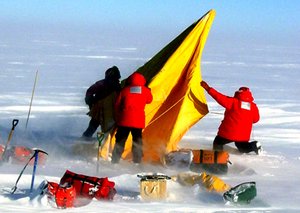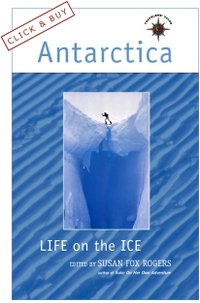XTRA, XTRA: Read All About The Antarctic Sun

The best and cheapest all-points-north bulletin on the planet is delivered right to your doorstep by clicking The Antarctic Sun, a fun and exciting, web-based magazine with "News about the US Antarctic Program, the Ice, and the People." Funded by the National Science Foundation, The Sun brings you incredible tales and characters from the bottom of the planet (not unlike Antarctica: Life on the Ice by Yours Truly).
The current edition of The Sun tells the amazing story of a subglacial mountain range beneath the high plateau in East Antarctica "the size of the European Alps but buried below hundreds of meters of ice and snow [that] has puzzled and enticed Antarctic scientists since its discovery 50 years ago."
 This photograph by Doug Wiens accompanies the article. It is a dramatic and true image of the conditions that Antarctic researchers routinely endure. Click on it to enlarge. Here's the photo's caption from The Sun:
This photograph by Doug Wiens accompanies the article. It is a dramatic and true image of the conditions that Antarctic researchers routinely endure. Click on it to enlarge. Here's the photo's caption from The Sun:
"Researchers headed into the field for the seismic instrumentation of the AGAP project in 2007-08 can expect the same sort of extreme weather conditions experienced during TAMSEIS (2001-03), a project in the Transantarctic Mountains that used an earlier generation of seismometers for similar research."
An excerpt follows from The Sun story.
The best and cheapest all-points-north bulletin on the planet is delivered right to your doorstep by clicking The Antarctic Sun, a fun and exciting, web-based magazine with "News about the US Antarctic Program, the Ice, and the People." Funded by the National Science Foundation, The Sun brings you incredible tales and characters from the bottom of the planet (not unlike Antarctica: Life on the Iceby Yours Truly).
The current edition of The Sun tells the amazing story of a subglacial mountain range beneath the high plateau in East Antarctica "the size of the European Alps but buried below hundreds of meters of ice and snow [that] has puzzled and enticed Antarctic scientists since its discovery 50 years ago."
This photograph by Doug Wiens accompanies the article. It is a dramatic and true image of the conditions that Antarctic researchers routinely endure. Click on it to enlarge. Here's the photo's caption from The Sun:
"Researchers headed into the field for the seismic instrumentation of
the AGAP project in 2007-08 can expect the same sort of extreme weather
conditions experienced during TAMSEIS (2001-03), a project in the
Transantarctic Mountains that used an earlier generation of
seismometers for similar research."
An excerpt follows from The Sun story.
"How did it get there? What does it look like? How tall is it? What role did it play in the formation of the ice sheet?
Those are a few of the questions an international team of researchers
will attempt to answer beginning this season, as they venture into the
Antarctic Gamburstev Province (AGAP), a high-altitude region in East
Antarctica.
“We don’t know why that mountain range is there. It’s really a
mystery,” said Robin Bell, a principal investigator for AGAP’s
aerogeophysical component, nicknamed GAMBIT. “It’s kind of like finding
a mountain range in the middle of Canada.”
A Soviet overland traverse discovered the Gamburtsev subglacial range
during the International Geophysical Year in 1958. Scant other data
exist aside from a few aerogeophysical surveys dating back to the 1970s.
A multi-nation effort to study the subglacial mountain range in more
detail came together as a result of the International Polar Year (IPY).
U.S. investigators are teaming with scientists from the United Kingdom,
Germany, China, France, Italy, Japan and Australia to tackle a place
that is logistically tough to work alone." The full text at The Antarctic Sun
Antarctica: Life on the Road
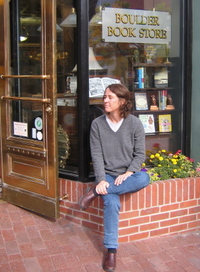 Antarctica: Life on the Ice hit the road this past weekend. First stop: Boulder, Colorado where I read with Traci Macnamara and Beth Bartel.
Traci brought a blow-up globe so that everyone would know where the
Antarctic is (not "up there with the polar bears"). She read from her
essay about spending Thanksgiving on the ice, while Beth read from her
essay that describes her time spent on Mt. Erebus. They were both
stars. In the audience were a lot of ice people, including Elaine Hood,
from Raytheon who was my guardian angel during my trip. And then there were friends and fellow writers BK Loren and Sallie Greenwood. Christine Weeber, who contributed to Solo: On Her Own Adventure showed up, as did Jenny Dellaport, from my hometown of State College, PA! Watch for news of more readings at my website: www.susanfoxrogers.com
Antarctica: Life on the Ice hit the road this past weekend. First stop: Boulder, Colorado where I read with Traci Macnamara and Beth Bartel.
Traci brought a blow-up globe so that everyone would know where the
Antarctic is (not "up there with the polar bears"). She read from her
essay about spending Thanksgiving on the ice, while Beth read from her
essay that describes her time spent on Mt. Erebus. They were both
stars. In the audience were a lot of ice people, including Elaine Hood,
from Raytheon who was my guardian angel during my trip. And then there were friends and fellow writers BK Loren and Sallie Greenwood. Christine Weeber, who contributed to Solo: On Her Own Adventure showed up, as did Jenny Dellaport, from my hometown of State College, PA! Watch for news of more readings at my website: www.susanfoxrogers.com
Antarctica: Life on the Ice hit the road this past weekend. First stop: Boulder, Colorado where I read with Traci Macnamara and Beth Bartel.
Traci brought a blow-up globe so that everyone would know where the
Antarctic is (not "up there with the polar bears"). She read from her
essay about spending Thanksgiving on the ice, while Beth read from her
essay that describes her time spent on Mt. Erebus. They were both
stars. In the audience were a lot of ice people, including Elaine Hood,
from Raytheon who was my guardian angel during my trip. And then there were friends and fellow writers BK Loren and Sallie Greenwood. Christine Weeber, who contributed to Solo: On Her Own Adventure showed up, as did Jenny Dellaport, from my hometown of State College, PA! Watch for news of more readings at my website: www.susanfoxrogers.com
Karen Joyce: Frozen Hard and Thawed Out
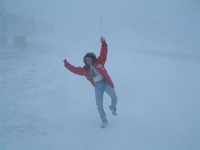 A storm has been walloping Antarctica for the past few days. Karen Joyce, intrepid to the end, has ventured out to take this photograph. I wish I’d been there…
A storm has been walloping Antarctica for the past few days. Karen Joyce, intrepid to the end, has ventured out to take this photograph. I wish I’d been there…
The contributors to Antarctica: Life on the Ice lead fascinating lives. From time to time I’ll track them down and find out what they are doing.
Karen, who contributed a hilarious essay, “The Day It Rained Chickens,” to Antarctica: Life on the Ice is currently in McMurdo, as she has been for the past 17 years during the austral summer. She will be joining us live from the Antarctic for our virtual book tour on November 29.
A storm has been walloping Antarctica for the past few days. Karen Joyce, intrepid to the end, has ventured out to take this photograph. I wish I’d been there…
The contributors to Antarctica: Life on the Ice lead fascinating lives. From time to time I’ll track them down and find out what they are doing.
Karen, who contributed a hilarious essay, “The Day It Rained Chickens,” to Antarctica: Life on the Iceis currently in McMurdo, as she has been for the past 17 years during the austral summer. She will be joining us live from the Antarctic for our virtual book tour on November 29.
“It's strange how much I love this place, even though I
am absolutely the wrong body type for Antarctica. Cold places select
for gigantism, for a ratio of surface area to interior space that
maximizes the latter, and I am a wee peanut of a woman. I have been
frozen hard and thawed out so many times, I ought to be a quaking
gelatinous mess by now.”
Karen should be working on her second novel, The Winter of My Discount
Tent but instead, this is what she reports from the ice:
“I dream
about missing airplanes, traveling in unrecognizable countries, always
enroute somewhere and there is always trouble. I suffer this job for 10 hours a day and in the evening I paint, teach
exercise classes, write and drink single-malt Scotch. For the first
time in my life, I count the days till I can leave, but I don't know
where I want to go. That's it in a nutshell.”
'Antarctica: Life on the Ice' Hits the Street!!!
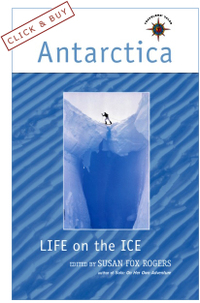
Antarctica: Life on the Ice is the just-released anthology that I collected and edited to bring you first-hand stories of those who devote their lives to the most beautiful and cruel environment on the planet -- Antarctica. Inside you will meet explorers, penguinologists, geologists, iceologists, cooks, pilots and others who have been drawn, almost mystically, to life at the bottom of the world.
In the 2004-2005 austral summer, I spent six weeks in the Antarctic as part of the National Science Foundation Antarctic Artists and Writers Program. Based at McMurdo Station, I also visited the South Pole, several camps in the Dry Valleys and Cape Royds. When I was a young girl, my father regaled me with stories of the Antarctic. To walk the terrain and visit the outposts of explorers like Scott and Cherry-Garrard was the fulfillment of a childhood dream.
Antarctica: Life on the Ice is the just-released anthology that I collected and edited to bring you first-hand stories of those who devote their lives to the most beautiful and cruel environment on the planet -- Antarctica. Inside you will meet explorers, penguinologists, geologists, iceologists, cooks, pilots and others who have been drawn, almost mystically, to life at the bottom of the world.
In the 2004-2005 austral summer, I spent six weeks in the Antarctic as part of the National Science Foundation Antarctic Artists and Writers Program. Based at McMurdo Station, I also visited the South Pole, several camps in the Dry Valleys and Cape Royds. When I was a young girl, my father regaled me with stories of the Antarctic. To walk the terrain and visit the outposts of explorers like Scott and Cherry-Garrard was the fulfillment of a childhood dream.
Following is an excerpt from my Introduction to Antarctica: Life on the Ice (Click here for the full Introduction and Table of Contents):
In the austral summer of 2005, I made a day trip by helicopter to
Robert Falcon Scott’s hut at Cape Evans on Ross Island. This was
Scott’s base in 1910, the expedition that ended with his death and the
death of four of his crew. The story of this expedition is one of the
saddest in Antarctic history and is my favorite, so to visit the hut
where they lived was a sort of pilgrimage. The hut was busy with a crew
of New Zealand men digging out ice from its south side. I
knew how the ice piled up there as I had read about it in Scott’s
journals and in Apsley Cherry-Garrard’s marvelous account of Scott’s
final expedition, The Worst Journey in the World. The men handed me a
pickax and for a while I chipped away with them with the great sense
that this small gesture connected me to the past, even to heroism. Soon
enough, though, this heroic traveler was tired, so I gave up my digging
and wandered into the hut.
Once my eyes adjusted to the dim light I stood, overwhelmed by what had
been left there: cans of collard greens and bottles of medical supplies
above Dr. Wilson’s bed; reindeer sleeping bags and finneskos (the
Norwegian-style boots). When I looked closely I could see that the
leather soles were peeling away. The daily lives of these explorers I
so admired became clear to me as I looked at Cherry-Garrard’s bunk bed,
and noted where Ponting processed his photos. When I saw toothbrushes
propped in glasses at the head of some of the men’s beds I wanted to
weep. For me, their lives were contained in those toothbrushes.
Daily details allow me to imagine a place and the bigger the place, the
more I need those details. Lucky for me, Scott’s narratives are filled
with passages like this from his 1901 expedition: “The first task of
the day is to fetch the ice for the daily consumption of water for
cooking, drinking and washing. In the latter respect we begin to
realize that many circumstances are against habits of excessive
cleanliness, but although we use water very sparingly, an astonishing
amount of washing is done with it, and at present the fashion is for
all to have a bath once a week.
A bath a week in melted ice water--for almost two years. With this sort
of detail the “heroic age” of Antarctic exploration is brought down to
the basics. What they ate, how they slept and other facts of daily life
make up much of the 1,200 pages of Scott’s narrative of his 1901
expedition. Readers are dragged through days of manhauling; along with
Scott and his men we suffer great cold and eat a lot of hoosh and
biscuits. It is these details that are the foundation their great feats.
What is remembered is the tragic manner in which Scott and his men died
in 1911, eleven miles from a food supply on their return from the pole.
A cross rests at the top of Observation Hill above McMurdo marking the
deaths of Scott, Bowers, Wilson, Evans and Oates. On it is inscribed
Tennyson’s great line: To strive, to seek, to find and not to yield.
When I arrived at the top of Observation Hill, breathless in the thin
clear air, tears emerged spontaneously and unexpectedly. I realized
that the cross told the same story as that contained in their
toothbrushes. I looked at the Ross Sea, made sure no one else was
nearby, and kissed the cross. (Click here for the full Introduction and Table of Contents)

